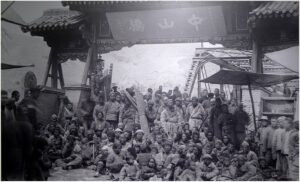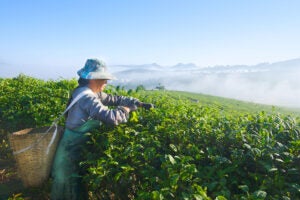Good heavens! The front page of The Wall Street Journal on Feb. 20 said that China is the obesity capital of the world. Jefferies Investment banking firm estimates there are 200 million obese adults in China and 400 million who are overweight. With a population of 1.41 billion, 200 million represents 14 percent of the population. Percentagewise, they have not yet caught up with the U.S., which has 139 million obese people, or 41.9 percent. But, as in so many other categories, they are closing in.
The backward country of the 20th century has essentially skipped the 20th and gone directly from the 19th to the 21st.
Up until the 1980s, there was a famine in some part of China nearly every year of the previous 2,000. But the greatest famine occurred from 1958 to 1962 because of Mao Zedong’s “Great Leap Forward.” Some estimates say 55 million died during those years because of poor crop production, poor food distribution, poor distribution of labor — requiring every household to have a backyard furnace to recycle used steel — and the forced collectivization of all peasant farmers into production communes. Calories available per person in 1961 were a measly 1,439 per day. In the U.S., available calories were 2,880.

After Mao’s mistakes were recognized and partly corrected, food availability began to rise. By 1980 it reached 2,161 calories per person per day; in the U.S. it was 3,175. Mao died in 1976, and the new leadership introduced some capitalistic reforms, such as allowing families to freely work a plot of land and be independent from the confines of a commune.
I was in China in January 1980 for two weeks with a group of 29 other Ag-Forestry Leadership participants. We observed 1920s technology everywhere — the farms, the cities, the five-story buildings with rickety elevators, and infrastructure. In one commune, a long line of workers — 100 or more — with hoes were seen tilling a large field, their hoes rising and falling in near unison. In another field, small family groups scattered around the field could be seen tilling their allotted acres.
China was relying on organic materials to fertilize its crops as it had for centuries. There were a lot of trucks on Chinese roads, and every fifth one was carrying night soil (human feces collected at night from cesspools and privies) in a 1,000-gallon tank to a country storage tank. I observed this fertilizing method first hand. A petite young woman carrying two 3-gallon buckets hanging from ropes on the ends of a stick across her shoulders, trotted up to a tank near where I was standing. A man opened a spigot and brown night soil filled the buckets to the brim. Putting the stick behind her neck and splaying her arms across it to steady her load, she took a few slow steps, then broke into a trot, the contents of the buckets undisturbed as she headed for her plot of land.
On another occasion, the bus I was riding in swerved to avoid something in the road. I looked out the window to see an old man sweeping horse biscuits into a dust pan. He paid no attention to traffic whizzing by him at 50 mph. Poop of any kind was a precious item to a farmer, worth risking his life.
Lack of crop nutrients was a major item holding back adequate food production in Mao’s China, and he knew it. Shortly after U.S. President Richard Nixon visited with Mao in 1972, Mao ordered 13 of the most modern Haber-Bosch industrial nitrogen-fixing plants from the U.S. Today, China produces about 25 percent of the world’s nitrogen fertilizer. The U.S is the second highest producer at about 11 percent.
After Mao’s death in 1976 the government relaxed its controls and introduced a bit of capitalism. The entrepreneurial spirit took hold in China. Food production and manufacturing blossomed. I returned to China in 1985 with another agricultural group. The changes were amazing. Where there had been nearly empty streets — except for bicycles — there were now modern freeways buzzing with cars. Construction cranes were everywhere in the cities. Where the tallest buildings had been five stories, there now stood high rise hotels and apartments.
But yet, there were incongruities: From my 30 story hotel window I heard a rooster crow early one morning.

With subsidies and more freedom to grow for the market instead of government quotas, farmers had become wealthy by Chinese standards. New houses could often be seen occupying a portion of their plot of land.
By the turn of the century China was self-sufficient in food and a net exporter. But as income, population and appetites rose, China returned to its status as a net importer. By 2018, food availability per capita in China had risen to 3,206 calories per day; in the U.S., 3,782. (To maintain current weight, females need 1,600 to 2,200 calories per day; men need 2,000 to 3,000.)
In the past 30 years, China has achieved dramatic results in agriculture, science and technology, much of it due to stolen technology from the U.S. and other developed countries — even stealing corn seeds from Iowa fields to improve their plant genetics. The U.S. government has finally become concerned and imposed sanctions on exporting advanced technology to China, especially in computer chips.
In the book, Has China Won, Kishore Malbubani argues it’s too late to try to limit China’s rise. Their science in all fields is well advanced, and they are capable of building their own chips and engineering their own seeds. The only thing that will slow them down is their own political philosophy. The current leader, Xi Jinping, may accomplish a slowdown with his desire to reign in capitalistic tendencies and return more production to government entities.
Jack DeWitt is a farmer-agronomist with farming experience that spans the decades since the end of horse farming to the age of GPS and precision farming. He recounts all and predicts how we can have a future world with abundant food in his book “World Food Unlimited.” A version of this article was republished from Agri-Times Northwest with permission.



